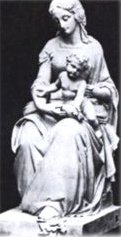The Betharram Shrine
The little village of Betharram is nowadays best known for its grottos. But it was once best known for being a place of pilgrimage, hence the shrine and the wayside.
The Betharram shrine
Since 7 or 8 centuries, the Virgin Mary is celebrated in the Betharram Shrine where she has three very popular names:
Our Lady of the Star: young shepherds discover in a burning bush a Virgin surrounded by light.
Our Lady of the Wayside: in July 1616, a large cross was erected on the hill over the Shrine. Two months later, a storm destructs it. It rises by itself in a halo of blinding light. During 200 years, the Shrine is called “Our Lady of the Wayside”. It is the origin of the beautiful Stations of the Cross, of which the main bas-reliefs were sculpted by Alexandre Renoir.
Our Lady of Betharram: Along the centuries, and mainly in the 17th century, the Virgin produced miracles and graces. According to Saint Vincent of Paul, Betharram is the second place of pilgrimage in the kingdom. Marca, the archbishop of Paris listed 82 miracles between 1620 and 1642: blind people, paralysed people, cancer cases or drowning people rescued by the Virgin.
These cases initiated a pretty legend: a girl fell in the Gave of Pau. The Virgin rescues her by reaching out a branch. The name Betharram comes from this legend: Béth Arram means Our Lady of the Branch in Bearnais, the local dialect.
Betharram wasn't spared by the French Revolution. But a saint, Michel Garicoïs, brought the shrine back to life and prosperity. He helped the needy people, and also listened to Bernadette Soubirous's confidences. He will found the congregation of the Priests of the Sacred-Heart, or the Betharram Fathers, who are currently active in 14 countries. He will die in Betharram on the 14th of May 1863, on the Ascencion Day. He was canonised on the 6th of July 1947.


The Betharram Museum
At the Betharram Museum, you will see diverse remainings of listed historical monuments and objects: an 18th century chimney and a fresco, a 1710 lectern, an ivory statue of Saint Peter, Limoges enamel (Saint Charles Borromée), a mutilated Virgin's head (relic of the first wayside), Marie-Antoinette's communion veil, several paintings, magnificent liturgical decoration, as well as coin, mineral and prehistoric collections.
The admirable wayside cross that was erected after the 1616 prodigy was destroyed during the French Revolution in 1793.
From 1840 to 1845, Saint Michel Garicoïs ordered the building of the current wayside, of which you can admire the beautiful bas-reliefs by Alexandre Renoir. It includes fifteen stations: Gethsemane, Judas's betrayal, Christ in front of Caiaphas, the Scourging, the Crowning with thorns, Ecce homo, Christ condemned to death, Christ bearing his cross meets his mother, the Women of Jerusalem, the Crucifixion, the three crosses, Christ's body taken down from the cross, Our Lady of the Wayside, the Entombment of Christ, Resurrection.
Bernadette Soubirous in Betharram
Bernadette Soubirous often came to Betharram. She went to the village four or five days before the apparitions. The rosary she used to tell her beads at the Massabielle Grotto came from the Betharram shrine. She immediately came to thank Our Lady of Graces of Lourdes.
Prior to any investigation, she was sent to Saint Michel by his Lordship Laurence. Saint Michel Garicoïs was the only man to believe straight away in the apparitions. To the ones who objected, that these apparitions would be Betharram's end in favour of Lourdes, he would answer: “Whatever, as long as the Saint Virgin is honoured!”
He went several times to Massabielle. He died in debt: he had 300 people to feed, works in progress, and had to support the new congregation. In spite of it all, he collected important amounts of money for the erection of the first Chapel in Lourdes.
Practical information
Have a look at the "Grottes de Bétharram" !
For all enquiries, please contact the father rector of the shrine:
Bétharram,
64800 Nay
FRANCE
Tél : 05.59.71.92.30
Website: click here